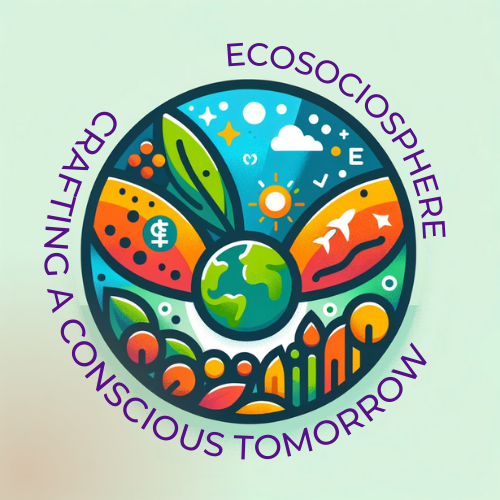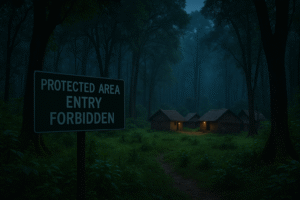Fun Fact: Trees “talk” to each other through underground fungal networks known as the “Wood Wide Web.”
We often see forests as peaceful places—good for a hike, a selfie, or maybe some birdwatching. But what if we told you that underneath all that green silence, there’s a bustling social network, a secret community more sophisticated than we ever imagined?
In “The Hidden Lives of Trees: What Forests Can Teach Us About Community,” we explore a world where trees care for each other, send warnings across vast distances, and even feed their sick or ageing neighbours. Yes, forests are not collections of solitary individuals but vibrant, interconnected communities. And if we pay attention, they just might teach us how to be better humans.
The Wood Wide Web: More Than Roots and Leaves
We tend to think of trees as lone warriors—rooted, immobile, and passive. But underground, they’re anything but isolated. Trees are connected through complex fungal networks—scientifically known as mycorrhizal (fungus-root) systems. These fungi form symbiotic relationships with trees, exchanging nutrients for sugars and serving as communication channels across the forest.
Dr. Suzanne Simard, a forest ecologist from the University of British Columbia, calls this the “Wood Wide Web.” It’s how trees send chemical signals to one another, warning of danger, calling for help, or sharing resources.
For example, when a tree is attacked by pests, it can release chemical cues through these networks to alert its neighbours, prompting them to increase their defences. Some trees, like the mother trees in old-growth forests, even “nurse” their saplings by sending extra carbon and nutrients underground.
Forests, in other words, function like extended families.
Tree Parenting and Community Care
One of the most heartwarming discoveries in recent years is that trees recognise and protect their offspring. “Mother trees”—the oldest, most connected trees in a forest—have been shown to favour their own kin. They direct more nutrients toward their “children,” helping them grow stronger and survive longer.
This isn’t sentimental fluff—it’s a well-documented phenomenon supported by years of ecological fieldwork.
But these mother trees don’t just care for their own. When a neighbouring tree is injured or dying, healthy trees have been observed transferring resources to support it. It’s an act of collective resilience. Imagine if our cities operated with such empathy.
Trees Talk with Chemistry
Besides underground messages, trees also communicate through the air using volatile organic compounds (VOCs). For example, acacia trees in Africa emit ethylene gas when grazed upon by giraffes. This gas alerts nearby acacias, which then quickly ramp up their tannin production to become unappetizing.
It’s a primitive warning system—like a natural WhatsApp group alerting others of a predator.
This chemical conversation isn’t limited to predator defence. Trees also use it to regulate growth, reproduce, and attract pollinators.

What Human Communities Can Learn from Forests
Interdependence Is Strength, Not Weakness
Modern society glorifies independence and self-reliance. Forests teach us that survival often depends on collaboration. Just like trees, people thrive in systems of mutual support.
Nurture the Young, Respect the Old
Mother trees not only protect saplings but also support other ageing trees. In India, where the elderly are often either venerated or neglected, this model suggests a more balanced, ongoing
Share Resources, Especially in Crisis
During drought or disease, stronger trees feed weaker ones via mycorrhizal networks. Imagine applying that logic to communities facing food shortages or health emergencies.
Communication Is Key
Forests show us the value of staying connected—not just digitally, but emotionally and physically. Signals, warnings, support systems—this is what sustains a community.
Indian Forests and Traditional Wisdom
India’s forests have long been recognized not just for their biodiversity but for the cultural and spiritual value they hold. Indigenous communities like the Bishnois of Rajasthan or the Dongria Kondh in Odisha have always treated trees as kin—not commodities.
In fact, the Chipko Movement of the 1970s, where women hugged trees to stop them from being cut down, was rooted in this deep understanding of the forest community. These were not “tree-huggers” in the pejorative sense. They were community defenders protecting their extended green family.
Forest Destruction Is Community Destruction
Unfortunately, rapid deforestation, mining, and monoculture plantations threaten not just ecosystems but also the entire community structure of forests. When we clear forests, we don’t just lose carbon sinks or animal habitats—we dismantle social networks.
Studies have shown that fragmented forests are less resilient to disease, climate change, and fire. Cut down mother trees, and the younger ones struggle to survive. It’s the ecological version of destroying elders who hold institutional memory.
Can Urban Spaces Learn from Trees?
Absolutely. Cities can mimic forests in structure and spirit. Urban planners are beginning to talk about “social infrastructure”—parks, libraries, community centers—that create bonds between people. Just like the Wood Wide Web, cities too need invisible networks that nourish connection.
In Pune, for example, citizen-led efforts like “Ped Lagao” (Plant Trees) have turned empty lots into mini-forests that not only clean the air but also bring neighbours together. In Delhi, urban forests like the Aravalli Biodiversity Park are not just lungs of the city—they’re learning centres and social gathering spots.
Conclusion: Forests Are Not Silent
Forests may appear still, but they are alive with conversation, collaboration, and care. The hidden lives of trees show us what a functional, compassionate society looks like—rooted in mutual aid, communication, and resilience.
If we can listen closely, they just might teach us how to heal our fragmented human communities. Because in the end, community—like a forest—isn’t about standing tall alone. It’s about growing together.
Author’s Note:
Forests are more than just ecosystems—they are living communities that embody cooperation, resilience, and quiet intelligence. By observing the natural connections between trees, we are reminded that thriving societies depend on mutual support and communication. As we continue to urbanise and expand, learning from nature’s wisdom is not optional—it’s essential.
G.C., Ecosociosphere contributor.
References and Further Reading:
- Simard, S. (2021). Finding the Mother Tree. Penguin Random House.
- Wohlleben, P. (2015). The Hidden Life of Trees. Greystone Books.
- “The Wood Wide Web: How trees secretly talk to each other.” BBC News. https://www.bbc.com/news/science-environment-38956030
- The World Beneath Our Feet Sacred Earth Trust. https://sacredearthtrust.in/the-world-beneath-our-feet/




